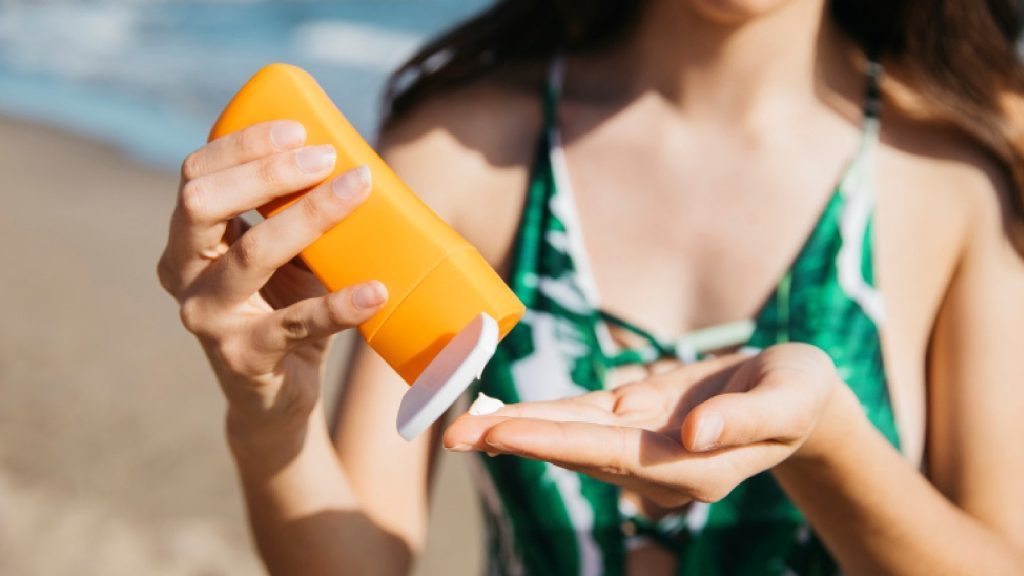Sunscreen is one of the most important products to protect your skin from sun damage. A dermatologist shares all about sunscreen ingredients.
Is choosing a sunscreen for your skin simply about the SPF or Sun Protection Factor that it offers? Ideally, there’s a lot more on the product label that you must check before you buy a sunblock. From the type it is – chemical or mineral – to sunscreen ingredients, picking the right sunscreen goes beyond just checking the SPF number, says a dermatologist.
“When finding a sunscreen, the best thing to look for is broad spectrum filters, stability, and antioxidants to protect your skin. As a dermatologist, many people ask me what to look for on the ingredients label, and I always tell them to just look at the label before they purchase a product. There are a few key ingredients and things to look for in a sunscreen,” Dr Vidushi Jain tells Health Shots.
Must-have ingredients in sunscreen
1. Zinc oxide and titanium dioxide:
These are called mineral or physical filters. They reside just on the skin surface, and reflect UV rays. They are non-irritating, and gentle, which make these products great for sensitive skin and for those who are all acne prone. “Zinc oxide and titanium do not penetrate the skin, therefore they are safe for children and pregnant women,” says Dr Jain.
2. Avobenzone:
Avobenzone is the most common chemical filter. It has extremely high absorption against UVA rays which mostly lead to photoaging, wrinkles and pigmentation. Avobenzone oxidizes and degrades extremely quickly in sunlight, so typically it has stabilizers such as octocrylene to improve efficacy.
3. Octocrylene:
Octocrylene has 2 purposes, it absorbs UVB rays and causes sunburn and it stabilizes avobenzone to improve efficacy. They typically do not cause any issues to most people skin, but it may sometimes trigger allergies in sensitive skin, so a patch test is advisable.
4. Mexoryl SX or Mexoryl XL:
Mexoryl SX and Mexoryl XL are modern UV filter components found in select professional, European sunscreens. When used together, they really do offer broad-spectrum protection, and most importantly, they are photostable. They do not break down upon significant sun exposure. If you can find a sticker for Mexoryl, you can trust and rank for your sunscreen while spending any time outdoors.
5. Helioplex Technology:
Helioplex is a proprietary technology that stabilizes the sunscreen agent, avobenzone. Helioplex allows the sunscreen to last longer on the skin too. If you see Helioplex in the packaging just know that the sunscreen will last longer because of the Helioplex.
6. Antioxidants (vitamin C, vitamin E, green tea extract):
A few sunscreens contain extra levels of antioxidants in addition to the UV filters to lessen free radical damage associated with sun exposure. Antioxidants are not a UV blocking agent but will add a layer of protection against oxidative stress to the skin.
7. Hyaluronic acid:
The first important step is choosing a proper sunscreen. Newer formulations of sunscreens may have other effective ingredients that are good for the skin, such as niacinamide (best for redness and pigmentation), and hyaluronic acid which helps with moisture retention. “These are not sun filters, these ingredients may be good for your skin health while increasing the multifunctional nature of your sunscreen,” adds the expert.
Dr Jain adds that if you are not wearing enough sunscreen and not reapplying every couple of hours, especially when you are outside, sunscreen is not worth it. Click to know how to use sunscreen correctly.
You may also like
DISCLAIMER: I hereby declare that I do not own the rights to this content. All rights belong to the owner. No Copyright Infringement Intended. If we have any information on our website that may affect your rights, please inform us at info@aihba and we will remove it immediately.







